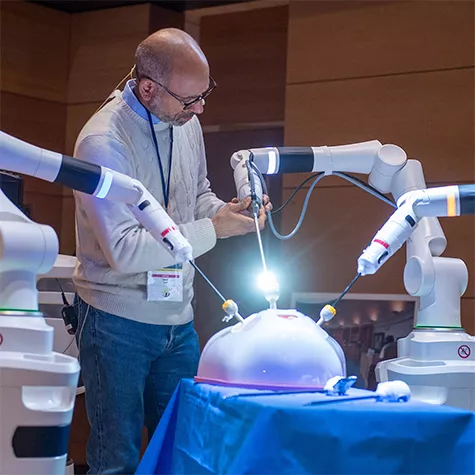CMR Surgical
3 Jan 2023
The last few years have seen an acceleration in the use of surgical robotics. It has been an exciting period for the surgical teams launching and expanding their robotic-assisted surgery (RAS) programmes. 2023 is likely to see increased demand for RAS around the world.
We asked some of our partners how they would summarise the last few years, and what predictions they have for surgical robotics in 2023.
Dr Hubert Oro, Head of Urology Surgery, Argenteuil Hospital, France
How would you describe the progress of RAS in recent years?
Great strides have been made in France in terms of uptake of robotic-assisted surgery — with France behind only the United States and Japan in terms of surgical robotics use. At Argenteuil, we are delighted to play our part and have seen increased use of surgical robotics, alongside other hospitals in the country. Hopefully this is a signal of the direction in which we are moving as a society.

What are your key focus areas for RAS in 2023?
In our robotics programme, we’re looking at how we can expand the type of procedures we are able to offer via RAS even further, such as colon and bariatric surgery. I also think data will be a big focus in 2023 — all surgeons using RAS should be able to harness the power of data to know their progress in each procedure type. We are also focusing on the potential of surgical robotics to help us recruit and retain talent to the hospital.
Vanash Patel, Consultant Colorectal Surgeon at West Hertfordshire Teaching Hospitals NHS Trust, United Kingdom
How would you describe the progress of RAS in recent years?
2022 saw incredible progress within surgical robotics at my hospital — we installed two surgical robots and increasing the number of specialties using the systems. The biggest challenge I faced personally was starting an RAS programme in a year where we had significant post-COVID-19 waiting lists and squeezed finances.
But with the biggest challenges come the most reward. In the months since we’ve incorporated Versius into our team, we’ve had a really positive response from patients. Whilst it’s too early for objective statements, as we don’t yet have a large enough data set, patients who have received RAS so far haven’t reported as much pain, particularly around the port sites, and I’ve noticed a reduction in interoperative blood loss. I’ve also been able to perform a bowel cancer resection on a high BMI patient, which I don’t think would have been possible via laparoscopy.

What are your key focus areas for RAS in 2023?
The training of surgical trainees is likely to be a key focus in 2023. Once consultants have been trained and are skilled, we need to train the future generation of surgeons. The main barriers are the costs of training programmes. However, as more and more consultant surgeons become trained, they will then be in a position to train trainee surgeons. We must continue to have close collaboration with the robotic industry and healthcare institutions to make this happen.
Prof. Paolo Pietro Bianchi, Director Department of Surgery, ASST-Santi Paolo e Carlo University of Milano, Italy
How would you describe the progress of RAS in recent years?
Our high-volume centre has been expanding its use of surgical robotics in the last few years. Currently it has all of the major surgical robotic platforms, and by the end of 2022 we performed more than 800 robotic procedures, distributed among four specialities. We have seen a significant increase in activity within general surgery, particularly in 2022, where many diverse robotic-assisted surgeries can be performed.

What are your key focus areas for RAS in 2023?
An important goal for us will be to increase the training offering for young surgeons starting their robotic activity. I believe that the increasing activity in surgical robotics will drive increased demand for training. The biggest limiting factor to date, is that there are few robots available for young surgeons to train on.
Data and digital are also of paramount importance. The more operations of a certain type that a surgeon performs, the more capable they become. Imagine the incalculable memory of a digital database and the usefulness it could have in the standardisation of surgical operations.
Dr Subhash Khanna, Swagat Hospital, India
How would you describe the progress of RAS in recent years?
There has been a sudden rise in the number of installations in recent years, after the introduction of newer robotic systems. We have also seen recent introduction of the RAS to various newer indications. I feel acceptance and adoption of RAS by general and GI surgeons has been the turning point in the expansion of RAS.

The main highlight of 2022 in our centre was the great benefit we could achieve so far where patient recovery is concerned. Although surgeon comfort due to better ergonomics was undoubtedly there, the biggest advantage for the patient was less pain and early return to work.
What are your key focus areas for RAS in 2023?
With many surgeons getting trained day-by day and with development of new robotic surgery techniques, more and more surgeons are going to procure the newer affordable systems and many more new techniques are going to be added to the surgeons’ armoury. My hospital is planning to have a consortium of specialist surgeons in the team in the forthcoming year.
The field of RAS is a novel field underlying rapid change. We must remain optimistic for the future of surgical robots as diversity inspires competition and competition breeds innovation and progress.